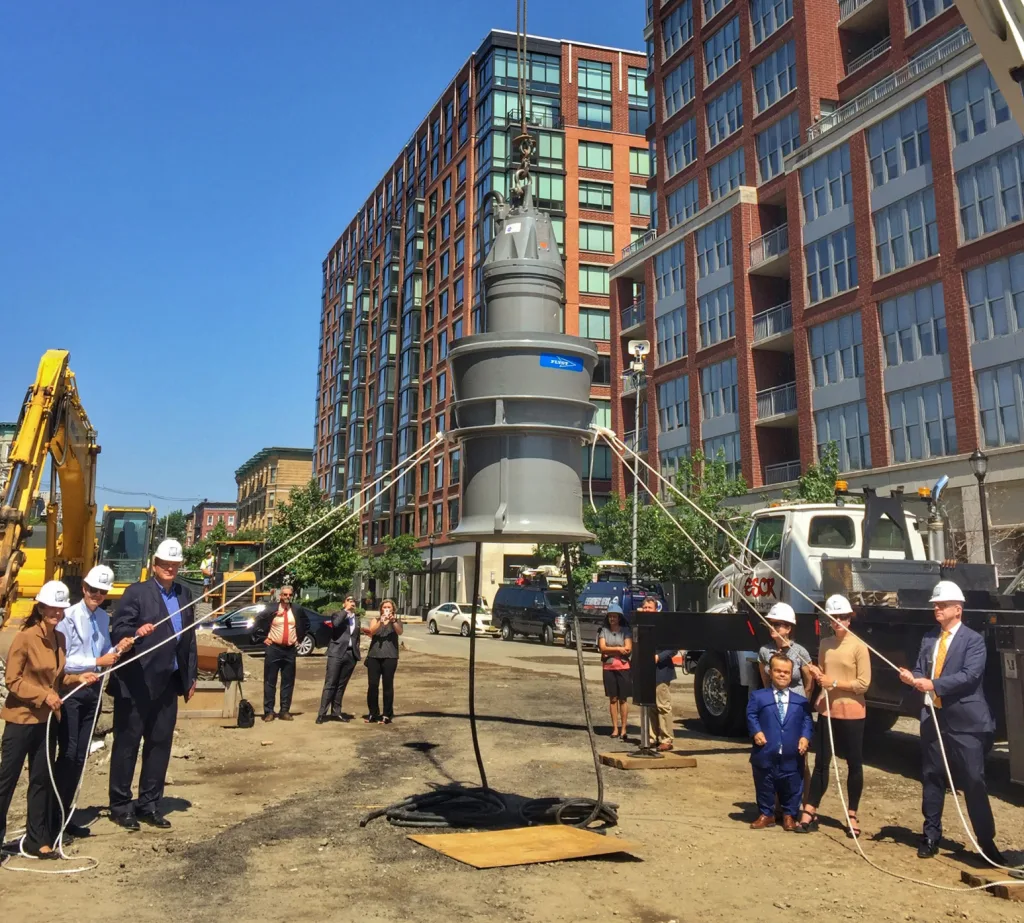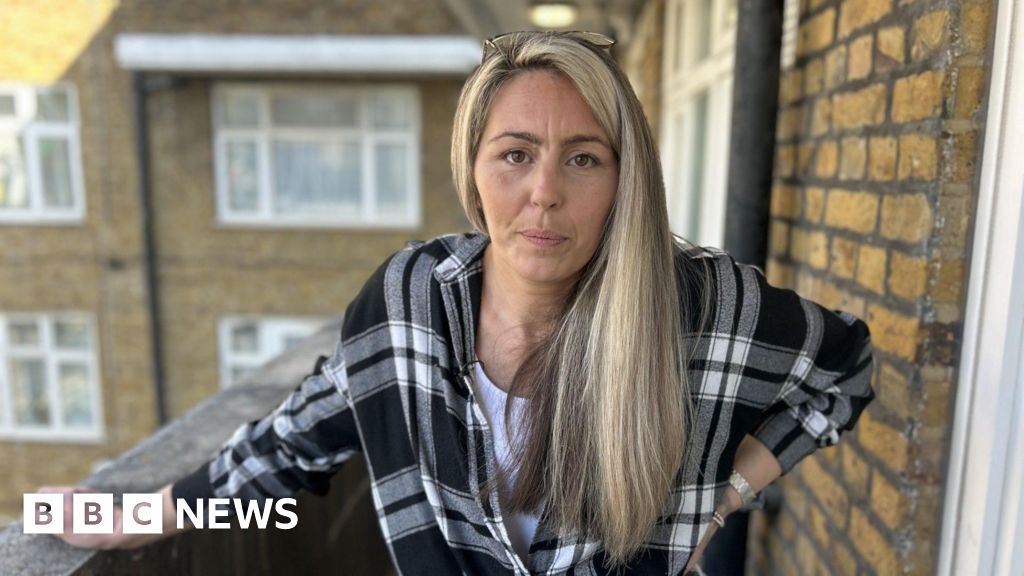Hoboken’s parks were redesigned to stop floods. Could New York City’s be next?

To most visitors, Hoboken’s ResilienCity Park might look like a normal (if rather upscale) park, complete with a large lawn for lounging, a playground, a basketball court, and an athletic field. But hidden in plain sight, the park has another purpose: keeping two million gallons of rainwater off of Hoboken’s streets by storing them in a giant underground tank.
The park—and others like it—is one of the main ways that Hoboken has transformed from a city devastated by Hurricane Sandy to one that, today, tends to recover from major rain within a matter of hours. Now, experts think New York City could use parks to follow Hoboken’s lead as extreme weather continues to worsen the city’s flood risk.

According to a study published today by Rebuild by Design, an organization dedicated to using design solutions to solve complex urban problems, 70% of NYC parks will be flooded by 2100. The report comes on top of another recent study from the Regional Plan Association (RPA), which found that, by 2070, as many as 82,000 housing units in and around NYC could be lost due to flooding by 2040, and the number could double to 160,000 by 2070.
Amy Chester, director of Rebuild by Design, believes that Hoboken’s example could help NYC protect both its parks and its housing by turning green spaces into a form of storm management.

How Hoboken’s parks keep its streets dry
In 2012, Hurricane Sandy flooded 80% of Hoboken, took out its power grid for two weeks, and cost the city $110 million in damages. In a recent talk shared to Rebuild by Design’s YouTube, Caleb Stratton, the city’s chief resilience officer, said that it was “a wake-up call for the city of Hoboken.”
The following year, Rebuild by Design was started as a design competition to promote resilience in regions that had been affected by Sandy. At the time, Chester says, cities were blindsided by both Hurricane Katrina and Hurricane Sandy: “We didn’t really understand resilient infrastructure as we do now,” she says.

That was especially true for Hoboken—which, despite its coastal location and long history of flooding, had almost no flooding mitigation infrastructure in place, Chester says. Hoboken’s proposed rain resilience project was one of Rebuild by Design’s six winning submissions, and over the last decade or so, the city has used more than $660 million from various sources including the United States Department of Housing and Urban Development (HUD), the state of New Jersey, and FEMA to implement new flooding protection measures.

Hoboken’s flooding resilience project includes several different levers. To keep floodwaters out, it’s building a 9,000-foot-long series of preventative seawalls, gates, and levies. It’s also updating its sewer system with more flood pumps to move water out of storage quicker during heavy rain. And, it’s keeping streets dry by increasing above and below ground water storage. That’s where resiliency parks come in.
So far, Hoboken has completed construction of three resiliency parks and a series of waterfront parks, with several more parks currently under construction. Each of these parks uses green infrastructure on its surfaces—like pervious pavers and rain gardens—which funnel water underground into holding tanks, keeping it out of the crowded sewer system and preventing overflows.

The ResilinCity Park, the largest of the existing parks, can hold two million gallons of water, enough to collect runoff from 20 surrounding blocks during a notable rain event (typically defined as more than a half inch of water falling in a 24-hour period), Chester says. A large chunk of that water is kept in the park’s underground tank, while some is held in other clever ways—like a sunken basketball court with a capacity to hold more than 100,000 gallons. In all, the existing parks can hold a total of 4.2 million gallons of water.
“It’s different from green infrastructure, because green infrastructure is on top of the park, and that stops the park from flooding. This is pumps and storage that stops the entire neighborhood from flooding,” Chester says. “We’re really interested in doing this all over New York City and in any urban areas where there are neighborhood parks, because if you’re a couple blocks away from a park, that park could be the storage option for your community and keep the floodwaters out of your basements and out of your streets.”
Rebuild by Design’s data shows that, in 2022 and 2023, Hoboken’s new rain resilient infrastructure led to an 88% reduction in flooding events. In practice, that meant that across 121 storms, noticeable flooding only occurred 14 times. In September 2023, when Hurricane Ophelia led to thigh-deep water in Brooklyn and flooded subway cars in NYC, Hoboken was noticeably dry.
Projects like these—which plan not just for seawater flooding, but also for excessive rainfall—are increasingly important as climate change ushers in rising sea levels, and as record-warm ocean temperatures lead to more intense annual storm seasons. According to the RAP’s recent analysis, NYC’s existing infrastructure is not prepared to account for the coming decades of flooding damage, which is expected to impact as many as 1.6 million New Yorkers by 2040. Chester thinks resiliency parks could be the first step toward preparing the city for what’s ahead.

Why NYC’s parks could help keep residents safe from flooding
Rebuild by Design’s new NYC park analysis maps all of the city’s 2,385 parks based on their current and future flood risk. Users can search the interactive map to view the parks in their own neighborhood, or filter for today’s flood risk and flood risk by 2100. The map is also color-coded based on FEMA’s social vulnerability index (or the susceptibility of social groups to the adverse impacts of natural hazards) and the heat vulnerability index, as parks provide the added benefit of reducing urban heat.
The tool shows that 38% of parks are currently in flood zones—a number that’s expected to surge to 70% by 2100. While these statistics may seem alarming, Chester sees them as an opportunity.
“We’ve mapped all of the floodplain in New York City and parks to see where [resiliency parks] could potentially be a solution,” Chester says. “We were able to show that 38% or 900 parks in New York City are currently on top of a flood plain. Interesting. Then if you look to the 2100 flood plain, it’s 70% of parks. That’s when we were like, ‘Oh my goodness. This could be really incredible to be thinking about this on a neighborhood-by-neighborhood basis.’”
Of all of NYC’s parks, Chester’s team has identified 177 sites that would benefit the most from a resilient makeover, based on both their flood risk and heat vulnerability. To make this happen, Chester says, the parks would have to be fully rebuilt to construct underground tanks that would pump water off of nearby streets, like the ResilienCity example—which “is why we need to start now,” she adds.
“If every time the parks department upgraded a park, they rebuilt it this way, we could have a major headstart in addressing flooding across NYC neighborhoods,” Chester wrote in a follow-up email to Fast Company. “All of Hoboken’s flood infrastructure was built in the past decade (after Sandy.)”
These parks are, admittedly, a major investment. ResilienCity, for example, cost $80 million, while the smaller Southwest Resiliency Park (which can hold about 200,000 gallons of water in its cistern) cost $12 million. However, Chester explains, pitching resiliency parks as flood protection can help to draw in new streams of federal and state funding.
“Parks manage 14% of the City’s land, but only about 0.6% of the City budget over the past 40 years, far below the national standard of 1–2% allocation of a municipality’s budget,” the Rebuild by Design interactive map page reads. “Parks offer immense potential to draw down federal and state funds, including programs from FEMA, HUD, and state funding. If the City were to recognize parks as vital infrastructure—as it does highways—and properly invest in upgrading and maintaining its parks, these public spaces could protect and save lives and save billions of dollars.”
For now, Rebuild by Design’s NYC proposal is just that. But Chester believes that, if Hoboken could implement successful resilient infrastructure in just a decade, there’s no reason that other cities can’t do it themselves.
“We’ve been working on this for a little while now, but like, it’s such an incredible model for urban areas nationally, because a majority of urban areas have neighborhood parks, and they’re these smaller areas that can be doing a lot more things,” Chester says. “None of these parks existed in Hoboken before, and Hoboken is not a city with a lot of money.”
What's Your Reaction?
 Like
0
Like
0
 Dislike
0
Dislike
0
 Love
0
Love
0
 Funny
0
Funny
0
 Angry
0
Angry
0
 Sad
0
Sad
0
 Wow
0
Wow
0

































































































